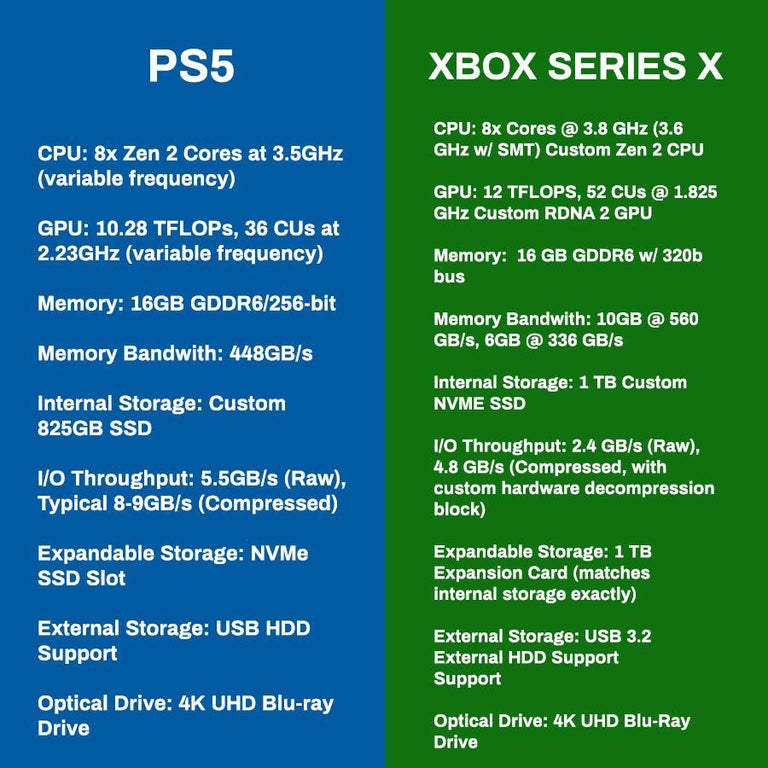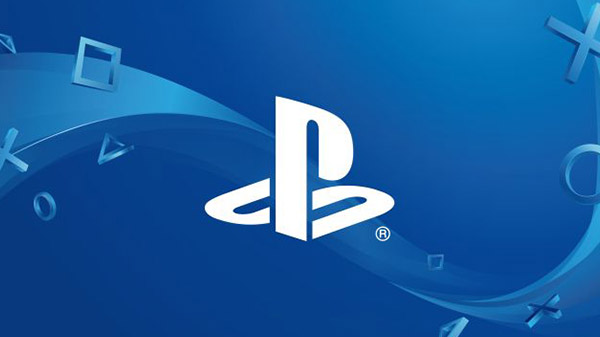With so many things cancelled, changed or altered, we finally have some good news, Sony revealed what we can expect from the PlayStation 5.
The fine folks over at Eurogamer were nice enough to compare the specs, found below:
| PlayStation 5 | PlayStation 4 | |
|---|---|---|
| CPU | 8x Zen 2 Cores at 3.5GHz (variable frequency) | 8x Jaguar Cores at 1.6GHz |
| GPU | 10.28 TFLOPs, 36 CUs at 2.23GHz (variable frequency) | 1.84 TFLOPs, 18 CUs at 800MHz |
| GPU Architecture | Custom RDNA 2 | Custom GCN |
| Memory/Interface | 16GB GDDR6/256-bit | 8GB GDDR5/256-bit |
| Memory Bandwidth | 448GB/s | 176GB/s |
| Internal Storage | Custom 825GB SSD | 500GB HDD |
| IO Throughput | 5.5GB/s (Raw), Typical 8-9GB/s (Compressed) | Approx 50-100MB/s (dependent on data location on HDD) |
| Expandable Storage | NVMe SSD Slot | Replaceable internal HDD |
| External Storage | USB HDD Support | USB HDD Support |
| Optical Drive | 4K UHD Blu-ray Drive | Blu-ray Drive |
While you can read the full article above to get a complete understanding of what these metrics mean and how it may or may not impact you in the future, here is an excerpt that gives you an idea of the scale of these changes.
Sony’s actual implementation is something else, with performance rated at two orders of magnitude faster than PlayStation 4. 2GB of data can be loaded in one quarter of a second, meaning that in theory, the entirety of PS5’s 16GB can be filled in just two seconds.
Eurogamer
Those looking for a bit more information can find Sony’s full presentation and overview below:
We know that fans are excited to find out more about our next-generation console, PlayStation 5, and exactly how it will bring about the future of gaming. Today we’re proud to unveil more details behind the technical and hardware components that make PlayStation 5 such an innovative and powerful platform – the ultra-high-speed SSD, integrated custom I/O system, custom AMD GPU with ray tracing, and highly immersive 3D audio. With these capabilities, PS5 will allow developers to maximize their creativity, building expansive worlds and new play experiences in the games they design.
This presentation from Mark Cerny, lead system architect for PS5, dives deep into the hardware system’s architecture and how we designed PS5 to benefit developers and the games they create.
As Mark discussed in his presentation, PS5’s ultra-high-speed SSD and integrated custom I/O system were developed with the goal of removing barriers to play – specifically loading screens. Developers are able to stream assets into PS5 games at an incredibly fast rate, so PS5 play experiences can be seamless and dynamic, with near-instantaneous fast travel through large game worlds. This enhanced speed will enable game developers to create larger, richer worlds without traditional limitations, such as load times, and also allows gamers to spend more time gaming than waiting.
We also wanted to introduce new capabilities with PS5’s custom GPU. Additional GPU power will allow for higher resolution in games, but a major new feature that benefits the visuals of games even further is ray tracing. Ray tracing simulates the way light moves in real life, and how it bounces off various surfaces. Games that take advantage of this feature will render objects much more accurately, and with heightened realism. Water, glass, light refraction, a character’s hair and so on, will look even more realistic.
PS5 will also allow games to offer a much deeper sense of immersion through 3D audio. Visuals are of course imperative to the gaming experience, but we believe audio plays a crucial role as well. We wanted to deliver a compelling audio experience for all users, not just those who own high-end speaker systems. So we designed and built a custom engine for 3D audio that is equipped with the power and efficiency for ideal audio rendering. With 3D audio on PS5, the sounds you hear while playing will offer a greater sense of presence and locality. You’ll be able to hear raindrops hitting different surfaces all around you, and you can hear and precisely locate where an enemy is lurking behind you.
Lastly, we’re excited to confirm that the backwards compatibility features are working well. We recently took a look at the top 100 PS4 titles as ranked by play time, and we’re expecting almost all of them to be playable at launch on PS5. With more than 4000 games published on PS4, we will continue the testing process and expand backwards compatibility coverage over time.
Make sure to keep an eye out for more PlayStation 5 updates down the road, and meanwhile, check out the chart below for the official list of PS5 specs.
PlayStation Blog
While this and the news Sony still expects to release this holiday season, there have been a lot of debates among players. The issue is actually rather simple. As seen with Reddit user onlypingal simple image, Xbox Series X is more powerful than the upcoming PlayStation 5.

In recent years this has been something of a standard, with Sony focusing less on achieving the most powerful thing and instead the best exclusives, which is the whole premise of the debate. Even though some people are wowed by the idea, it doesn’t matter if games aren’t worth it. Given Sony’s long standing history of amazing first party titles, it stands to reason PlayStation 5 will continue to deliver, meaning Microsoft still needs to wow players if they hope to come out ahead. Still, it’s great to see strong competition and ideally this will result with consumers coming out ahead.

